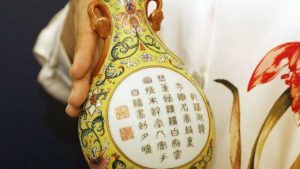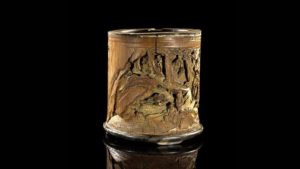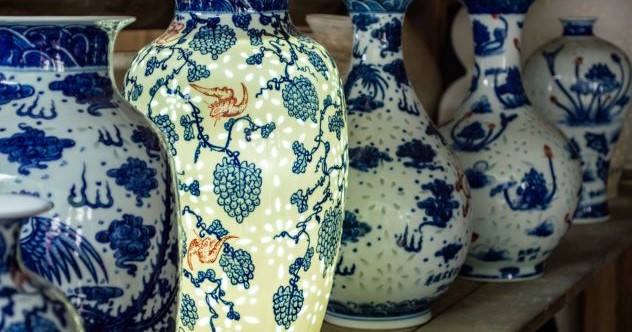It is a common trope in comedy that if a clumsy person enters an antique shop, they are bound to knock over a precariously positioned and priceless Ming vase. For centuries, collectors in the West have sought out the rarest Chinese antiquities, of which Ming vases are just the most famous. As China has boomed economically recently, the prices of Chinese artworks have exploded.
This has led to many cases where people who were about to throw away an old pot or donate a cracked plate to a junk shop have suddenly discovered they are actually in possession of something worth a fortune. Here are ten cases where Chinese antiques turned out to be a windfall.
Related: 10 Amazing Antiques Roadshow Discoveries
10 £1 Million Collection in the Attic
Clearing out the attic can be one of the most annoying tasks for any homeowner. It’s dusty and full of spiders, and then you have to decide which of the things you have stored over the years is worth keeping and which should be put in the trash. Sometimes, though, you might just strike gold.
Edward Radcliffe became an antiques dealer just before WWII, and during his career, he built up a nice collection of Chinese antiques. Some of them were so exquisite that he lent them out to museums around the world. But for some reason, after he died, this collection was dumped in the attic and forgotten for over 50 years before his family decided to get it valued.
Among the stars of the collection was an enamel box made for the Xuande emperor of the Ming Dynasty in the 15th century. Finding one is phenomenally rare, as just four are known to exist in the world. The family must have been pleased when it was valued at 10,000 pounds at auction. They must have been beyond belief when the hammer went down, and it was sold for £288,000. With the rest of the collection selling as well, the whole lot made nearly 1 million pounds.[1]
9 “Teapot”
The British love a cup of tea, so it is not unusual to find an elderly relative who has a teapot or two stored in their home. In 2020, a man finally sorted through the things his parents had stored in their attic. He found a plastic bag containing a tiny metal and enamel teapot, brought from China in the 1940s by his father. He thought of taking it to a charity shop. Instead, it was taken to an auctioneer who valued it at £100-150.
It soon became clear that it was actually something more special than a teapot. It turned out to be an imperial wine ewer made for the Qianlong emperor in the 18th century and one of only three in the world. On the day of the auction, nine bidders from around the world competed to own the minuscule masterpiece, and eventually, it sold for £380,000.
The owner, a construction worker, was thrilled with his sudden fortune. Asked what he would do with the money, he suggested he might buy a metal detector. With luck like his, who knows what treasures he might find.[2]
8 Imperial Vase
Familiarity breeds contempt, so something we see every day tends to get overlooked. When an auctioneer visited a friend’s house one day, he noticed that an old vase they had just in their kitchen looked quite special. The tall vase had been bought for a few hundred pounds and was a pretty piece of porcelain – but to the owners, it was nothing too exciting.
It was only years later that the piece, made at the Imperial Court of the Qianlong emperor, was put up for sale, and collectors began to get excited. The rich blue vase is decorated with gold and silver and depicts cranes and bats flying against a cloudy sky. A vase of this age, with this decoration and in this size, caused a stir, and it was valued at around £100,000.
Bidding was fierce, and the vase was sold for £1.2 million. Not bad for an old thing shoved in the kitchen.[3]
7 Loose Change Bowl
Pottery is a sturdy material but easily broken and damaged. For collectors of antiques, even the smallest chip can destroy the value of a piece, so most will do everything possible to protect their treasures. One family inherited a bowl owned by a well-known collector of Chinese antiques but did not give it the same care as he might have liked. They placed it in a guest room where friends would drop their keys and coins while they stayed.
It was only out of curiosity that they took the 9-inch (22.9-cm) wide turquoise glazed dish to an open day at an auctioneer’s event. It was immediately seen to have been produced for the early Ming Imperial Court. Known as a narcissus bowl, the object caused the valuers’ hands to shake, and the owners were happy to put it up for auction.
The bowl sold for £240,000. Hopefully, the new owner doesn’t toss metal objects into it.[4]
6 Cracked Umbrella Stand

Sometimes, we are given things and don’t know what to do with them, but we hold onto them anyway for sentimental reasons. One couple in England had come into possession of a blue and white vase as a gift and thought no more of it for 50 years. They relegated it to a spare room, and since it was about the right size, they placed their umbrellas in it. Needless to say, this was not the right way to treat the vase.
The vase turned out to have been made for the court of the Qianlong emperor and had survived centuries mostly intact. Unfortunately, the years of being an umbrella stand had left their mark on the vase, with it being cracked and scarred on the inside. Despite the damage, it was still valued at around £500,000.
Buyers seemed able to overlook the hard life the vase had endured and ended up paying £765,000.[5]
5 Umbrella Stand
There must be something about priceless Chinese vases that makes people look at them and think, “That would make an excellent umbrella stand.” When an expert from Christie’s auction house was made aware of a large, blue and white dragon vase that had once been an umbrella stand, he asked the French owners whether he could inspect it in person. As soon as he looked at it, he knew that the vase was a perfect example of 15th-century Ming Imperial pottery.
The umbrella stand phase of the vase’s life had miraculously left no trace on the flawless glaze. The large dragon motif was as fresh as the day it had been painted by the imperial artisans. When the vase was put up for auction in Hong Kong, excited bidding led to it reaching $20,447,642.[6]
4 Yard Sale Bowl
Everyone likes a bargain, and there is nowhere you can pick up an excellent deal as easily as at a yard sale. People use yard sales to get rid of the various stuff they have accumulated over the years and generally just want it out of the house. For $35, you can grab a pretty bowl for your home—or one that might make you a fortune at auction.
When a buyer saw a small blue and white bowl at a yard sale, they liked it so much they didn’t bother to haggle over the $35 price tag. Almost straight away, they suspected they had bought something special and alerted an auction house. It was found that the bowl was Ming porcelain made in the early 15th century in a form called a lotus bowl—with only six examples in museums around the world.
The bowl sold for $721,800, a mere 29,000 times more than it was bought for.[7]
3 Qianlong Vase

Thrift shops are great places to browse for unusual things because you never know what people have donated. You get to buy things cheap and also help a good cause. Sometimes, you really do find something special.
One shopper spotted a somewhat gaudy-looking vase with a yellow glaze and Chinese characters painted on it. It was only marked at £1 so they decided to buy it. Thinking it might be worth a little more than that, they put the vase on sale on eBay. However, as the price started to skyrocket, they removed it from the site and showed the vase to an auctioneer.
The vase was made at the court of the Qianlong emperor, and a mark on the base stated that it was not meant to be exported from the country. How it came to be in a charity shop in England is not known. At auction, the vase sold for £480,000. [8]
2 Brush Pot Donation

Thrift stores do not always let valuable antiques slip through their fingers. Volunteers who sort through donated objects are often given advice on spotting potentially important pieces and having them shown to experts. When one worker at St. Peter’s Hospice charity shop in Bristol, England, picked up a cracked old wooden pot that had been handed in and, for some reason, suspected it might be special—despite it not looking very promising.
The pot turned out to be a brush pot used in calligraphy and was made from bamboo around 1700, which perhaps explained why it was so cracked. Not only did the pot have a charmingly carved landscape scene on it, but it was also created by Gu Jue, one of the foremost bamboo workers at the time.
Luckily for the charity, this precious little object did not end up on their shelves and sell for a pittance. It went to auction and sold for £360,000, far outstripping the estimate of £15,000.[9]
1 Shoebox Vase
If this list does nothing else, it should make you consider clearing out your attic. The ultimate case of a treasure lurking in the attic comes from France and involves one of the finest Chinese vases ever to be offered for sale.
Sotheby’s auctioneer might well have missed out on this discovery as the owner of the vase simply sent them an email saying she had found some Asian objects in her attic as she prepared to move but would not be able to send them any photographs. Some other details she provided suggested they might be worth looking at, so they invited her to bring them in. Riding on the metro, she carried the vase in a shoebox. The owners had relegated it to the attic after deciding it was “too pink” for their tastes.
The vase, with its animal motifs, was so lovely that even if it had been a copy of what it looked like, it still might have been worth €100,000. However, the experts recognized it as genuine. It really was a vase made for the Qianlong emperor’s birthday and given an auction estimate of €700,000. It blew past this when bidding started and finally sold for €16,182,800.[10]
